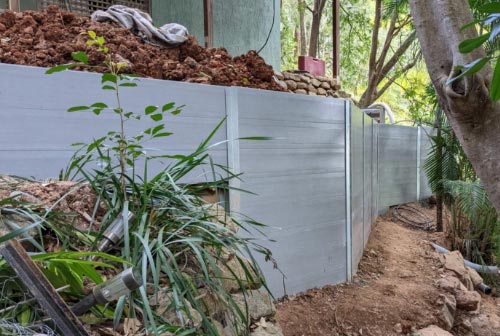In the realm of civil engineering, the composite retaining wall stands as a testament to innovation and adaptability. Combining diverse materials to combat soil erosion and provide structural support, these walls have become indispensable in modern construction projects. Let's explore the intricacies and advantages of composite retaining walls.
Construction:
Composite retaining walls are crafted through a meticulous process that integrates various materials to optimize strength and functionality. Typically, these walls incorporate components such as timber, concrete, and steel. Timber adds a natural aesthetic and flexibility, while concrete lends solidity and endurance. Steel reinforcements further bolster the structure, ensuring resilience against external pressures.
The construction process involves meticulous planning and precise execution to achieve optimal results. Engineers analyze the terrain, soil composition, and environmental factors to design a retaining wall that seamlessly integrates with its surroundings. Advanced techniques such as soil nailing and anchoring may be employed to enhance stability and longevity.
Durability and Stability:
One of the primary advantages of composite retaining walls is their exceptional durability and stability. By harnessing the unique properties of each material, these walls can withstand the rigors of time and nature. Concrete provides a solid foundation, resisting erosion and deformation, while timber offers flexibility to accommodate ground movement and seismic activity.
Moreover, the combination of materials enhances the overall structural integrity of the retaining wall, mitigating the risk of collapse or failure. Steel reinforcements act as a backbone, distributing loads evenly and preventing deformation under pressure. This ensures long-term stability, safeguarding infrastructure and surrounding areas from potential hazards.
Environmental Consciousness:
In an era marked by growing environmental awareness, composite retaining walls shine as eco-friendly solutions to soil erosion and land management. Timber, sourced from sustainable forests, promotes responsible forestry practices and reduces carbon footprint. Additionally, the longevity of composite walls minimizes the need for frequent replacements, further reducing environmental impact.
Furthermore, the integration of natural elements such as timber into the landscape enhances aesthetic appeal and biodiversity. Composite retaining walls can blend seamlessly with their surroundings, preserving the natural beauty of the environment while serving a practical purpose.
Applications:
The versatility of composite retaining walls lends itself to a myriad of applications across various industries. From transportation infrastructure to commercial developments and residential projects, these walls play a crucial role in shaping the built environment. They provide support for roadways, railways, and bridges, preventing soil erosion and ensuring the safety of commuters.
In urban settings, composite retaining walls offer space-saving solutions for landscaping and architectural design. Their ability to contour to uneven terrain enables developers to maximize land usage while maintaining structural integrity. Additionally, these walls can be customized to complement the aesthetic of parks, plazas, and public spaces, enhancing their visual appeal and functionality.
Conclusion:
Composite retaining walls embody the marriage of engineering prowess and environmental consciousness, offering a sustainable solution to soil erosion and land management. Through the strategic integration of diverse materials, these walls provide unparalleled durability, stability, and aesthetic appeal. As we continue to confront the challenges of urbanization and environmental degradation, composite retaining walls stand as beacons of innovation, shaping the landscape of the future.
 +86 15303735673
+86 15303735673 Jessica@frpzs.com
Jessica@frpzs.com
 Technical Data
Technical Data












